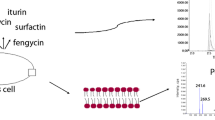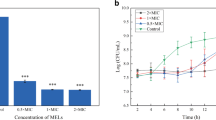Abstract
The antimicrobial properties of methyl (MTS) and ethyl (ETS) esters of thiosulfonic acid alone and in combination with rhamnolipid-biosurfactant (RL) have been characterized for their ability to disrupt the normal physiological functions of living pathogens. Bactericidal and fungicidal activities of MTS and ETS and their combination with rhamnolipid were demonstrated on strains of Pseudomonas aeruginosa, Bacillus subtilis, Alcaligenes faecalis, and Rhizopus ngtricans. It was found that the combination of rhamnolipid and thiosulfonic esters has a synergistic effect leading to decreasing of bactericidal and fungicidal concentrations of MTS and ETS. More extensively was studied the effect of rhamnolipid on the lipid composition of B. subtilis bacterial membrane. To our knowledge, in this article is reported for the first time a remarkable increase of negatively charged phospholipid cardiolipin in the presence of rhamnolipid. The capacity of RL as a surface-active substance was confirmed by scanning electron microscopy (SEM). The occurrence of surface infolds and blebs on B. subtilis shown by SEM, was not accompanied by changes in membrane permeability tested by a live/dead viability staining for fluorescence microscopy. When RL was applied in combination with MTS, a dramatic permeability shift for propidium iodide was observed in vegetative cells.



Similar content being viewed by others
References
Al-Tahhan RA, Sandrin TR, Bodour AA, Maier RM (2000) Rhamnolipid induced removal of lipopolysacharide from Pseudomonas aeruginosa: effect on cell surface properties and interaction with hydrophobic substrates. Appl Environ Microbiol 66:3262–3268
Ayres HM, Payne DN, Furr JR, Russell AD (1998) Effect of permeabilizing agents on antibacterial activity against a simple Pseudomonas aeruginosa biofilm. Lett Appl Microbiol 27:79–82
Bligh EC, Dyer WH (1959) A rapid method of total lipid extraction and purification. Can J Biochem Physiol 37:911–917
Bunthof CJ, Van Schalkwijk S, Meijer W, Abee T, Hugenholtz J (2001) Fluorescent method for monitoring cheese starter permeabilization and lysis. Appl Environ Microbiol 67:4264–4271
Carrera M, Zandomeni RO, Fitzgibbon J, Sagripanti J-L (2007) Differences between spore sizes of Bacillus antraci and other Bacillus species. J Appl Microbiol 102:303–312
Epand RM, Epand RF (2009) Lipid domains in bacterial membranes and the action of antimicrobial agents. Biochim Biophys Acta 1788:289–294
Epand RM, Rotem S, Mor A, Berno B, Epand RF (2008) Bacterial membranes as predictors of antimicrobial potency. J Am Chem Soc 130:14346–14352
Jean-François F, Castano S, Desbat B, Odaert B, Roux M, Metz-Boutigue MH, Dufourc EJ (2008) Aggregation of cateslytin beta-sheets on negatively charged lipids promotes rigid membrane domains. A new mode of action for antimicrobial peptides? Biochemistry 47:402–6394
Kawai F, Shoda M, Harashima R, Sadaie Y, Hara H et al (2004) Cardiolipin domains in Bacillus subtilis marburg membranes. J Bacteriol 186:1475–1483
Kenneth T (2008) Online textbook of Bacteriology. http://www.textbookofbacteriology.net
Lopez CS, Alice AF, Heras H, Rivas EA, Sanchez-Rivas C (2006) Role of anionic phospholipids in the adaptation of Bacillus subtilis to high salinity. Microbiology 152:605–616
Lubenets VI, Vasylyuk SV, Novikov VP (2005) Synthesis of S-(3-chloroquinoxalin-2-yl) esters of aliphatic and aromatic thiosulfonic acids. Chem Heteroc Comp 41:1547–1548
Lubenets V, Vasylyuk S, Baranovych D, Komarovska-Porokhnyavec O, Rayevska K, Zaichenko O, Novikov V (2007) The plant protection remedies of thiosulfonate type. Chem Agric Environ 8:163–167
Matsumoto K, Kusaka J, Nishibori A, Hara H (2006) Lipid domains in bacterial membranes. Mol Microbiol 61:1110–1117
Mileykovskaya E (2007) Subcellular localization of Escherichia coli osmosensory transporter ProP: focus on cardiolipin membrane domains. Mol Microbiol 64:1419–1422
Mukhopadhyay R, Huang KC, Wingreen NS (2008) Lipid localization in bacterial cells through curvature-mediated microphase separation. Biophys J 95:1034–1049
Nielsen L, Kadavy D, Rajagopal S, Drijber A, Nickerson KW (2005) Survey of extreme solvent tolerance in gram-positive cocci: membrane fatty acid changes in Staphylococcus haemolyticus grown in toluene. Appl Environ Microbiol 71:5171–5176
Nishi H, Komatsuzawa H, Fujiwara T, McCallum N, Sugai M (2004) Reduced content of lysyl-phosphatidylglycerol in the cytoplasmic membrane affects susceptibility to moenomycin, as well as vancomycin, gentamicin, and antimicrobial peptides, in Staphylococcus aureus. Antimicrob Agents Chemother 48:4800–4807
Pinkart HC, Wolfram JW, Rogers R, White DC (1996) Cell envelope changes in solvent-tolerant and solvent-sensitive Pseudomonas putida strains following exposure to o-xylene. Appl Environ Microbiol 62:1129–1132
Polyansky A, Ramaswamy R, Volynsky P, Sbalzarini I, Marrink S, Efremov R (2010) Antimicrobial peptides induce growth of phosphatidylglycerol domains in a model bacterial membrane. J Phys Chem Lett 1:3108–3111
Ramos JL, Duque E, Gallegos MT, Godoy P, Ramos-Gonzalez MI, Rojas A, Teran W, Segura A (2002) Mechanisms of solvent tolerance in gram-negative bacteria. Annu Rev Microbiol 56:743–768
Rivardo F, Turner RJ, Allegrone G, Ceri H, Martinotti MG (2009) Anti-adhesion activity of two biosurfactants produced by Bacillus prevents biofilm formation by human bacterial pathogens. Appl Microbiol Biotechnol 83:541–553
Ryu EK, MacCoss M (1979) Modification of Dittmer-Lester reagent for detection of phospholipid derivatives on thin layer chromatography. J Lipid Res 20:561–563
Schlame M (2008) Cardiolipin synthesis for the assembly of bacterial and mitochondrial membranes. J Lipid Res 49:1607–1620
Sotirova A, Spasova D, Vasileva-Tonkova E, Galabova D (2007) Effects of rhamnolipid-biosurfactant on cell surface of Pseudomonas aeruginosa. Microbiol Res 164:297–303
Sotirova A, Spasova D, Galabova D, Karpenko E, Shulga A (2008) Rhamnolipid-biosurfactant permeabilizing effects on Gram-positive and Gram-negative bacterial strains. Curr Microbiol l56:39–644
Spizizen J (1958) Transformation of biochemically deficient strains of Bacillus subtilis by deoxiribonucleate. Proc Natl Acad Sci USA 44:1072–1078
Tsai M, Ohniwa RL, Kato Y, Takeshita SL, Ohta T, Saito S, Hayashi H, Morikawa K (2011) Staphylococcus aureus requires cardiolipin for survival under conditions of high salinity. BMC Microbiol. doi:10.1186/1471-2180-11-13
Vatsa P, Sanchez L, Clement C, Baillieul F, Dorey S (2010) Rhamnolipid biosurfactants as new players in animal and plant defense against microbes. Int J Mol Sci 11:5095–5108
Weber FJ, Isken S, de Bont JAM (1994) Cis/trans isomerization of fatty acids as a defence mechanism of Pseudomonas putida strains to toxic concentrations of toluene. Microbiology 140:2013–2017
Acknowledgments
This study was supported by the Cooperation Joint Project D002-34/2008 between the Bulgarian and Ukrainian Ministries of Education and Science.
Author information
Authors and Affiliations
Corresponding author
Rights and permissions
About this article
Cite this article
Sotirova, A., Avramova, T., Stoitsova, S. et al. The Importance of Rhamnolipid-Biosurfactant-Induced Changes in Bacterial Membrane Lipids of Bacillus subtilis for the Antimicrobial Activity of Thiosulfonates. Curr Microbiol 65, 534–541 (2012). https://doi.org/10.1007/s00284-012-0191-7
Received:
Accepted:
Published:
Issue Date:
DOI: https://doi.org/10.1007/s00284-012-0191-7




